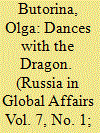| Srl | Item |
| 1 |
ID:
087864


|
|
|
|
|
| Publication |
2009.
|
| Summary/Abstract |
The current crisis is often seen as a match to the Great Depression of the 1930s. Yet there is a hope that it would not evolve into a humanitarian disaster. The standard of living in the crisis-hit countries is much higher now than 80 years ago, and they are not facing the threat of all-out unemployment or poverty. The world's GDP is not going to fall by one quarter within the next few years, and hungry people will not be marching to Washington or other capitals, while inhuman dance marathons, such as the one in Sydney Pollack's movie is likely to forever remain a screenplay.
The two crises are similar in that they both began in the United States, with financial upheavals quickly engulfing the manufacturing sector and a majority of regions of the world. The key common characteristic is the breakdown of market mechanisms. In the 1930s, it was caused by the first wave of globalization. Production technologies changed dramatically at the turn of the 20th century: there was a breakthrough in the development of transport and communications, and transnational oil companies were established and gained a firm footing. As a result, certain national and colonial economies were drawn into the world economic system. The collapse of the New York Stock Exchange on October 24, 1929 put an end to an erratic market. It turned out that market forces could not run the world economy without an active participation by the state.
|
|
|
|
|
|
|
|
|
|
|
|
|
|
|
|
| 2 |
ID:
160022


|
|
|
|
|
| Summary/Abstract |
Chavang Kut, a post-harvesting festival in Manipur, represents an important cultural expression of the Chin-Kuki-Mizo group of people. The article looks at the participation of the Thadou community in the celebration by tracing their performative historiography. In the past, the celebration was primarily important in the religio-cultural sense. The rhythmic movements of the dances in the festival were inspired by animals, agricultural techniques and showed their relationship with ecology. Today, the celebration witnesses the shifting of stages and is revamped to suit new contexts and interpretations. The traditional dances which forms the core of the festival is now performed in the out-of-village settings and are staged in a secular public sphere. While used by the state as a political project to bring unity amongst the different communities of Manipur, recent socio-political occasions showed how it is used as a site of contestations against the state.
|
|
|
|
|
|
|
|
|
|
|
|
|
|
|
|